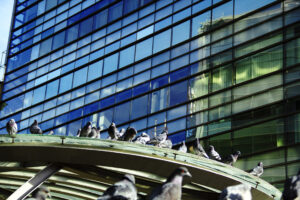Bird Control Solutions for Your Business
Birds present a unique challenge in commercial facilities. They can easily navigate between properties that are miles apart and deliver pathogens (in their droppings) that contain harmful bacteria including listeria, E. coli and salmonella.

Birds can easily navigate between properties that are miles apart and deliver pathogens in their droppings that contain harmful bacteria.
These pathogens can be brought inside a facility on the sole of an employee’s shoe, on unprocessed commodities or on food processing equipment or preparation areas if the birds gain access. The consequences of having tainted food products are quite serious and that is why bird activity in a food processing plant is the top reason audits and inspections fail.
Timing is Everything
Early spring is a crucial time for commercial properties to get ahead of potential nuisance bird issues at their facilities. The timing is important since most species of protected migratory birds have not yet returned from their winter exploits in warmer climates, making last season’s nesting and roosting sites empty.
This provides commercial properties and their pest management service providers a window to remove the nesting and roosting sites and take the necessary preemptive measures to deter the birds from reestablishing those nests.
Migratory birds including swallows, finches, robins and other species protected under the federal Migratory Species Act of 1918. Once they have established an active nest in a commercial property they cannot be touched.
Keith Rowney, Sprague’s manager of bird control services and a certified bird control specialist, says the existence of a nesting site isn’t the real issue, but the presence of eggs or hatchlings are the cease-and-desist points for removing the nest.
The Regulatory Impact of Birds
Bird management work in and around commercial facilities, especially food processing and packaging facilities, has taken on added importance under the Food Safety Modernization Act.
More restrictive enforcement of audit standards by third-party and government auditors, and an emphasis on the safe stewarding of food and packaging materials from farm to table, has commercial facility and QA managers paying much closer attention to their bird management protocols.
Rowney says food processing and packaging facilities must be pro-active in their efforts to prevent nuisance birds from threatening the facility and its products.
“There is a heightened awareness of the risks birds pose to commercial food processing facilities and auditors and inspectors are more likely to recognize those risks and act on them during an audit or inspection,” says Rowney.
Keeping Facilities Bird-Free
What steps can QA and facility managers take to keep their facilities bird-free? Rowney says birds require the deepest and widest toolbox of any pest to manage, and he offers the following tips:
- Look beyond the four walls of your facility for bird issues. Exposed stacks of shipping pallets outside a structure with droppings on them could cause you to fail an audit.
- Any bird sightings on fixtures or equipment – inside or outside – could be a cause for concern with auditors as can the presence of fecal matter, feathers or nesting materials.
- Have a professional pest management conduct a bird management needs assessment for your facility, develop an action plan to correct any issues and reevaluate the work that is done for effectiveness.
Discover The Sprague Difference
If you are looking for an innovative bird control solution for your commercial property, connect with the Sprague pest management experts at 800.272.4988.

